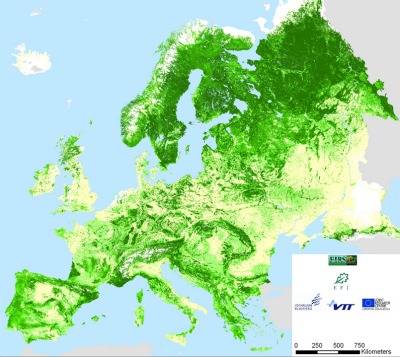
- North Karelia, Finland
- Kronoberg, Sweden
- Wales, UK
- South-East Veluwe, Netherlands
- Black Forest, Germany
- Montafon Valley, Austria
- Prades, Spain
- Chamusca, Portugal
- Panagyurishte, Bulgaria
- Carpathians, Romania
- European
|
Climate change challenge
 Europeís forests are very diverse, among others due to differences in soil, climate and management history. However, one commonality of European forestry is that forests are actively managed, and for most forests in Europe, management is an important factor determining species composition, structure and future development. Historically, ideal managed forests were even-aged and monospecific timber production systems, and this was reflected in the dominance of these forests in large parts of Europe. In the last decades, increased attention for biodiversity has caused a shift towards more nature-oriented forest management. Proposed Natura 2000 sites largely overlay with current forest areas. On the other hand, the demand for biofuels is increasing, leading to the establishment of short rotation coppices and removal of harvesting residues. Climate change will probably lead to increased forest productivity in the boreal zone, but increased heat and drought will put the forests in the Mediterranean region under severe stress. Climate change might also provoke a change in disturbances regimes, either directly (storm climate) or indirectly (more favourable conditions for fires and insect outbreaks).
Europeís forests are very diverse, among others due to differences in soil, climate and management history. However, one commonality of European forestry is that forests are actively managed, and for most forests in Europe, management is an important factor determining species composition, structure and future development. Historically, ideal managed forests were even-aged and monospecific timber production systems, and this was reflected in the dominance of these forests in large parts of Europe. In the last decades, increased attention for biodiversity has caused a shift towards more nature-oriented forest management. Proposed Natura 2000 sites largely overlay with current forest areas. On the other hand, the demand for biofuels is increasing, leading to the establishment of short rotation coppices and removal of harvesting residues. Climate change will probably lead to increased forest productivity in the boreal zone, but increased heat and drought will put the forests in the Mediterranean region under severe stress. Climate change might also provoke a change in disturbances regimes, either directly (storm climate) or indirectly (more favourable conditions for fires and insect outbreaks).
Response to the challenge
It is expected that tree species will expand their range northwards, and loose terrain at their southern edge. However, this natural migration will take place only slowly. Forest managers could anticipate to these changes by introducing more southern provenances or more southern tree species in their forests. Current aims in forest management at each location should be checked with expected future climate conditions, and options for the future need to be assessed. These might include adapting management strategies, introducing new species, or adapt the forest management aims. Due to the diversity in environmental conditions, management strategies and forest policies at the European scale, the outcome of this process will be different everywhere. We will use the experiences in the other case studies as a basis to assess the underlying rationales and mechanisms and we will try to scale this up to the European level.
Who will carry on the research and what models are applied
For this case study, we will apply the EFISCEN-Space model, which is able to simulate forest development and management at the scale of 1km2 throughout Europe. This case study is lead by Alterra Wageningen UR and contact person is Mart-Jan Schelhaas (martjan.schelhaas(at)wur.nl).
Where the case study is situated, who owns the land
The European case study encompasses about 170 million ha of forests in the EU27 countries plus Switzerland and Norway, with a huge variety in climate, soil, tree species, ownership and management.

